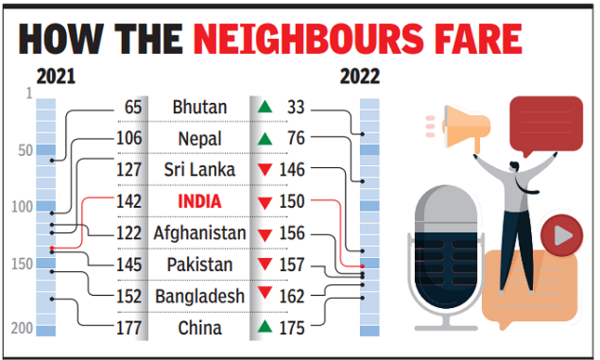Context
-
Recently, the global media watchdog, Reporters Without Borders (RSF) has released World Press Freedom Index 2022.
Key Findings of World Press Freedom Index 2022
Indian Scenario
- India’s ranking in the 2022 World Press Freedom Index has fallen to 150 out of 180 countries.
- In last year’s report, India was ranked 142.

Source: Times of India - The ranking of India’s neighbours, except that of Nepal, have also slid down, with the index placing Pakistan at 157th position, Sri Lanka 146th, Bangladesh 162nd and Maynmar at 176th position.
- Nepal has climbed up by 30 points in the global ranking at 76th position. Last year, the Himalayan nation had been placed at 106th position.
Global Scenario
- The top three positions for countries with the highest press freedom were taken by the Nordic trio of Norway (a score of 92.65), Denmark (90.27) and Sweden (88.84) while Estonia (4th) and Finland (5th) grabbed the 4th and 5th positions.
- North Korea remained at the bottom of the list.
- Russia was placed at 155th position, down from 150th last year, while China climbed up by two positions with the Reporters Without Borders placing it at 175th position. Last year, China was placed at 177th position.
- The world’s 10 worst countries for press freedom include Myanmar (176th), China (175), Turkmenistan (177th), Iran (178th), Eritrea (179th) and North Korea (180th).
What are the findings with regard to world press freedom?
- In terms of global trends, the report flags a “two-fold increase in polarisation amplified by information chaos — that is, media polarisation fuelling divisions within countries, as well as polarisation between countries at the international level.”
- It notes that “within democratic societies, divisions are growing” due to the spread of “opinion media” and the rise of “disinformation circuits” amplified by how social media functions.
What does the Index say about India?
- The report states that in India, “the violence against journalists, the politically partisan media and the concentration of media ownership all demonstrate that press freedom is in crisis”.
- Describing India as “one of the world’s most dangerous countries for the media”, the report notes that “journalists are exposed to all kinds of physical violence including police violence, ambushes by political activists, and deadly reprisals by criminal groups or corrupt local officials.”
- It highlights that “supporters of Hindutva, the ideology that spawned the Hindu far-right, wage all-out online attacks on any views that conflict with their thinking.”
What are the report’s observations on India under various indicators?
- Under ‘political context’, it states: “Originally a product of the anti-colonial movement, the Indian press used to be seen as fairly progressive but things changed radically in the mid-2010s
- With regard to ‘legal framework’, the report notes that “Indian law is protective in theory but charges of defamation, sedition, contempt of court and endangering national security are increasingly used against journalists critical of the government”.
- Under ‘economic context’, the report, describing Indian media as a “colossus with a feet of clay”, points out that “media outlets largely depend on advertising contracts with local and regional governments” and “at the national level, the central government has seen that it can exploit this to impose its own narrative, and is now spending more than ₹130 billion (5 billion euros) a year on ads in the print and online media alone.
- Finally, on the socio-cultural indicators of press freedom, the report, noting that “the enormous diversity of Indian society is barely reflected in the mainstream media,” states that “for the most part, only Hindu men from upper castes hold senior positions in journalism or are media executives — a bias that is reflected in media content.”
Back to Basics
What is RSF and what’s the objective of this Index?
- RSF is an international NGO whose self-proclaimed aim is to defend and promote media freedom.
- Headquartered in Paris, it has consultative status with the United Nations.
- The objective of the World Press Freedom Index, which it releases every year, “is to compare the level of press freedom enjoyed by journalists and media in 180 countries and territories” in the previous calendar year.
- The RSF defines press freedom as “the ability of journalists as individuals and collectives to select, produce, and disseminate news in the public interest independent of political, economic, legal, and social interference and in the absence of threats to their physical and mental safety.”
What is the methodology used by RSF to assess and rank countries?
- Countries are ranked after being assigned a score ranging from 0 to 100, with 100 representing the highest possible level of press freedom and 0 the worst.
- The scoring has two components:
- a quantitative one, that tallies abuses against journalists and media outlets, and
- a qualitative analysis based on the responses of press freedom specialists (journalists, researchers, human rights defenders) to an RSF questionnaire.
- Countries are evaluated on five contextual indicators:
- political context,
- legal framework,
- economic context,
- socio-cultural context, and
- safety
Reference:
Visit Abhiyan PEDIA (One of the Most Followed / Recommended) for UPSC Revisions: Click Here
IAS Abhiyan is now on Telegram: Click on the Below link to Join our Channels to stay Updated
IAS Abhiyan Official: Click Here to Join
For UPSC Mains Value Edition (Facts, Quotes, Best Practices, Case Studies): Click Here to Join
